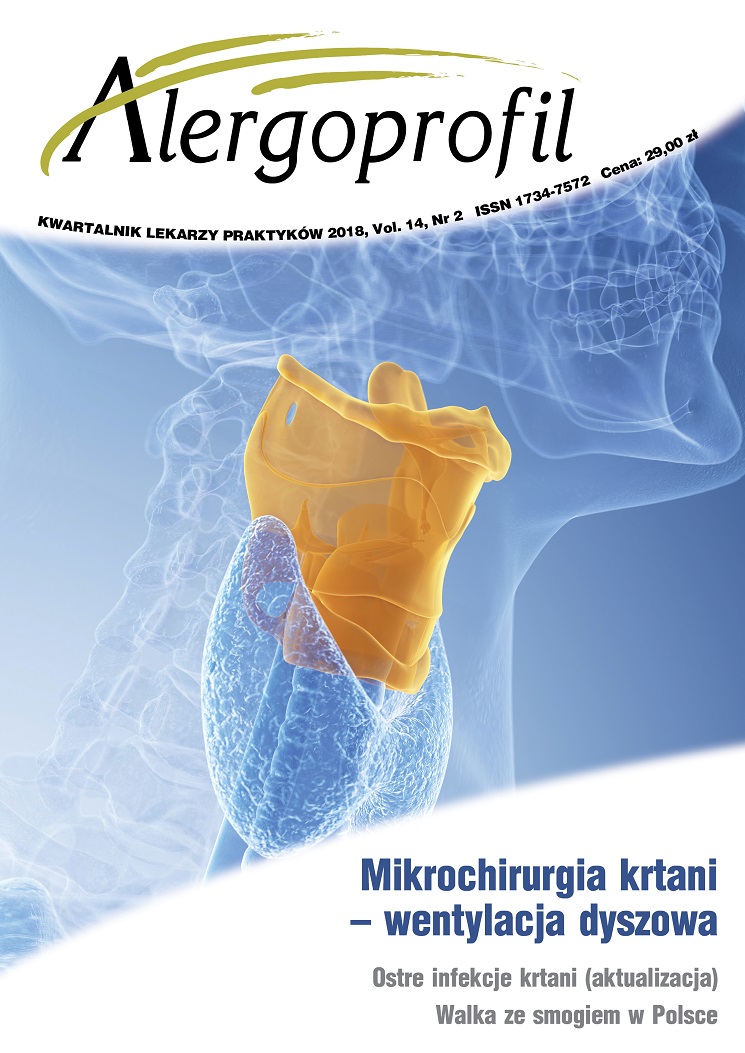Interdyscyplinarna współpraca w mikrochirurgii krtani z zastosowaniem lasera CO2 i znieczulenia ogólnego z użyciem wentylacji dyszowej
##plugins.themes.bootstrap3.article.main##
Abstrakt
Wstęp: Zabiegi mikrochirurgiczne krtani wymagają swobodnego dostępu do pola operacyjnego. Takie możliwości stwarza znieczulenie ogólne z użyciem wentylacji dyszowej. Wspólny obszar działania laryngologa i anestezjologa wymaga współpracy.
Materiał i metodyka: Badaniem objęto grupę 40 pacjentów zakwalifikowanych do mikrochirurgii krtani z użyciem lasera CO2. Badana grupa składała się z 20 chorych ze zmianami złośliwymi i 20 chorych ze zmianami niezłośliwymi. Ryzyko znieczulenia oceniano według skali ASA. Wykluczono chorych przed 18. i po 80. r.ż., z ciężką obturacyjną chorobą płuc oraz niewydolnością nerek i wątroby. W pracy przedstawiono zasady kwalifikacji do zabiegów i sposób prowadzenia znieczulenia ogólnego. Warunki intubacji oceniano według skali Kriega, a warunki operacji przeprowadzanej przez laryngologa w skali Likerta.
Wyniki: Proponowany sposób znieczulenia umożliwiał sprawne i bezpieczne wykonanie procedur anestezjologicznych i laryngologicznych. Warunki pracy zostały wysoko ocenione przez laryngologa.
Dyskusja: Operacje mikrochirurgiczne krtani z zastosowaniem wentylacji dyszowej są obarczone wysokim ryzykiem powikłań. Ich bezpieczne przeprowadzenie jest możliwe przy ścisłej współpracy zespołów anestezjologicznego i laryngologicznego.
Pobrania
##plugins.themes.bootstrap3.article.details##
Copyright: © Medical Education sp. z o.o. This is an Open Access article distributed under the terms of the Attribution-NonCommercial 4.0 International (CC BY-NC 4.0). License (https://creativecommons.org/licenses/by-nc/4.0/), allowing third parties to copy and redistribute the material in any medium or format and to remix, transform, and build upon the material, provided the original work is properly cited and states its license.
Address reprint requests to: Medical Education, Marcin Kuźma (marcin.kuzma@mededu.pl)
Bibliografia
2. Shah S.M., Kapadi M.S., Shah D.R. et al.: Anaesthesia For Laser Surgery Of Larynx. Gujarat Med. J. 2014, 69(1): 17-20.
3. Babinski M., Smith R.B., Klain M.: High-frequency jet ventilation for laryngoscopy. Anesthesiology 1980, 52: 178-180.
4. Evans E., Biro P., Bedforth N.: Continuing Jet ventilation. Education in Anaesthesia. Crit. Care Pain 2007, 7(1): 2-5.
5. Jaquet Y., Monnier P., Van Melle G. et al.: Complications of Different Ventilation Strategies in Endoscopic Laryngeal Surgery A 10-year Review. Anesthesiology 2006, 104: 52-59.
6. MacMillan M.H., Davidson M.: Anaesthesia for endoscopic surgery. Anaesth. Intens. Care Med. 2017, 18(4): 196-198.
7. Krieg N., Mazur L., Booij L.H., Crul J.: Intubation conditions and reversibility of a new non-depolarizing blocking agent, NC-45. Acta Anaesthesiol. Scand. 1980, 24: 423-425.
8. Tang F., Li S.Q., Chen L.H., Miao C.H.: The comparison of various ventilation modes and the association of risk factors with CO2 retention during suspension laryngoscopy. Laryngoscope 2011, 121(3): 503-508.
9. Murphy G.S.: Neuromuscular Monitoring in the Perioperative Period. Anesth. Analg. 2018, 126(2): 464-468.
10. Paech M.J., Kaye R., Baber C., Nathan E.A.: Recovery characteristics of patients receiving either sugammadex or neostigmine and glycopyrrolate for reversal of neuromuscular block: a randomised controlled trial. Anaesthesia 2018, 73: 340-347.
11. Huh H., Park S.J., Lim H.H. et al.: Optimal anesthetic regimen for ambulatory laser microlaryngeal surgery. Laryngoscope 2017, 127(5): 1135-1139.
12. Choi E.S., Oh A.Y., Koo B.W. et al.: Comparison of reversal with neostigmine of low-dose rocuronium vs. reversal with sugammadex of high-dose rocuronium for a short procedure. Anaesthesia 2017, 72: 1185-1190.
13. Wang H., Yang C., Zhang B. et al.: Efficacy of target-controlled infusion of propofol and remifentanil with high frequency jet ventilation in fibre-optic bronchoscopy. Singapore Med. J. 2013, 54(12): 689-694.
14. English J., Norris A., Bedforth N.: Anaesthesia for airway surgery. Continuing Education in Anaesthesia, Critical Care & Pain 2006, 6(1): 28-31.
15. Kitching A.J., Edge C.J.: Lasers and surgery. Br. J. Anaesth. 2003, 8(5): 143-146.
16. Cook T.M., Alexander R.: Major complications during anaesthesia for elective laryngeal surgery in the UK: a national survey of the use of high-pressure source ventilation. Br. J. Anaesth. 2008, 101(2): 266-272.
17. Mikkelsen S., Knudsen K.E.: Pneumopericardium associated with high-frequency jet ventilation during laser surgery of the hypopharynx in a child. Eur. J. Anaesthesiol. 1997, 14(6): 659-661.
18. Gilbert T.: Gastric rupture after inadvertent esophageal intubation with jet ventilation catheter. Anestesiology 1998, 88: 537-538.

